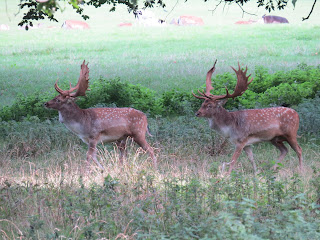 |
| Fallow Deer at Holkham Hall |
Forget about spending lots of money for a ringside seat to see two of the greatest fighters to grace the ring, when you can visit Holkham Hall for a few quid to see a battle between a bunch of heavyweights hoping to win a chance to father as many offspring as possible. It can only mean that the annual rut has begun! With two species of deer on the estate to see (red and fallow), it felt like a great day of antler-on-antler action was at hand.
 |
| Fallow Deer Buck |
We did not have to go far to see deer today, as a small fallow deer herd was grazing close to the car park. This was just the tip of the iceberg as the main bulk of the estate's fallow deer population was gathering on the field on the otherside of the wood bordering the car park that this small herd was in. We followed the small herd join this mega herd, keeping our distance and using trees as cover. The deer were not bothered by our presence and instead carried on grazing. Most of them were does (females) with a few youngsters with them.
 |
| Fallow Deer Doe |
 |
| A fight between two bucks as we approached |
 |
| Just a small section of the mega herd |
Mingling with them were several bucks (males). Some were too young to compete this year due to the size of their antlers, but this did not stop them from practising with mock fights. In this video below, you can see two young bucks doing just that.
 |
| Practising to fight! |
 |
| A bellowing buck |
We were just leaving our hiding spot behind a large oak and out of the small woodland, when the sudden grunted bellows of two mature bucks made us look back. These two heavyweights sized each other up as they wandered into the area we were just in. It felt like two men taking the fight outside away from everyone. They walked parallel of each other between the trees, looking at one another with the scent of testosterone filling the air. Then, it all kicked off! They both lowered their heads and clashed antlers for a moment. Between short intervals, they clashed a few more times before leaving the woodland to rejoin the herd. It was unclear of who the victor was with tree trunks distorting our view, but it was quite an even fight.
 |
| Sizing each other up! |
 |
| Clash of the heavyweights! |
 |
| The victor roaring triumphantly? |
 |
| Holkham Hall |
 |
| Red Deer |
Behind the manor, on the otherside of the estate, our search for the red deer took a while before we finally found them. They were much harder to approach, so we watched them from afar. We could only see a small portion of the herd that were hidden around the corner in a much denser woodland. The ones we could see were more out in the open and were either grazing or lying down on the grass. At first, we could only see a couple of young males with antlers with fewer prongs branching out. The older the deer gets, the number of prongs it develops increases. Eventually, about two to three mature stags with a set of impressive antlers appeared from out of the wood. The odd roar was heard as the dominant stag shows off his masculinity along with shaking branches with his antlers and rubbing them in his own urine.
 |
| A young Red Deer Stag (a male red deer) |
 |
| Red Deer Hind (a female red deer) |
 |
| An impresseive set of antlers! |
 |
| The dominant stag (for now) |
 |
| Two hinds chasing a stag off |
Sadly, all this led to nothing. I did not see a fight, but I did see the females backing the stags away with a flick of a front leg. It is strange to think that it is actually the females who call the shots dispite all the aggression shown from the dominant stag. If a female isn't happy with his performance, she will leave him for a better man. The rut has only just begun and throught the next month, the dominant stag has a lot to do as he fends off his rivals and mate with as many females as he can, all while not eating or sleeping. Chances are, he will not remain the dominant stag by the end of October. But the victor is not decided by the amount of fights he won, but by the number of offspring he fathers. You will have to wait for summer and be a scientist to find out who won this year's rut.
Apart from deer, I also found the first pink-footed goose skein of the autumn and these fungi growing from the grass. (If you know what they are, I would love to know).
 |
| Pink-footed Geese |
 |
| Some kind of toadstool growing from the grass |
 |
| Some kind of waxcap I think |
 |
| Two small toadstools growing from the grass |






























































